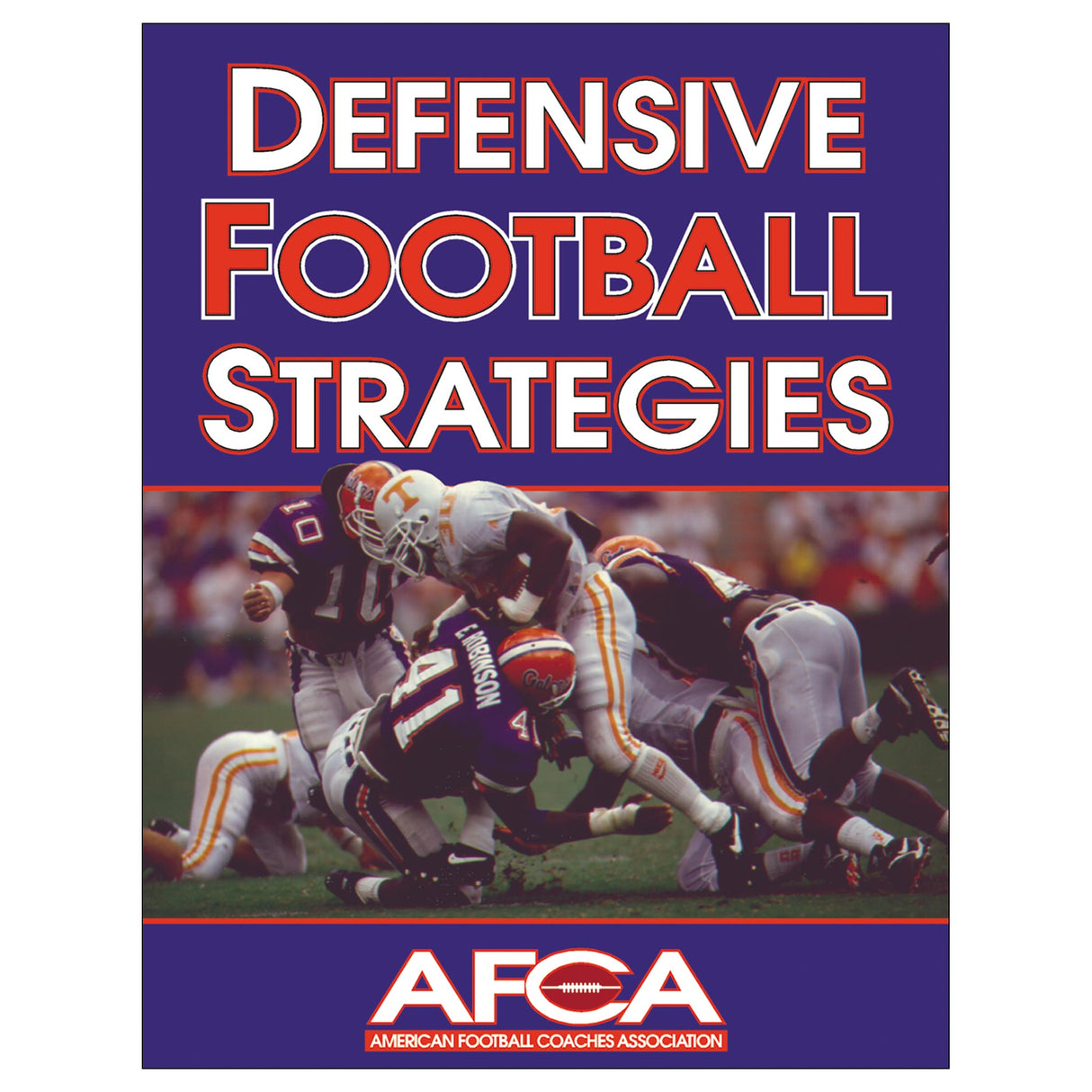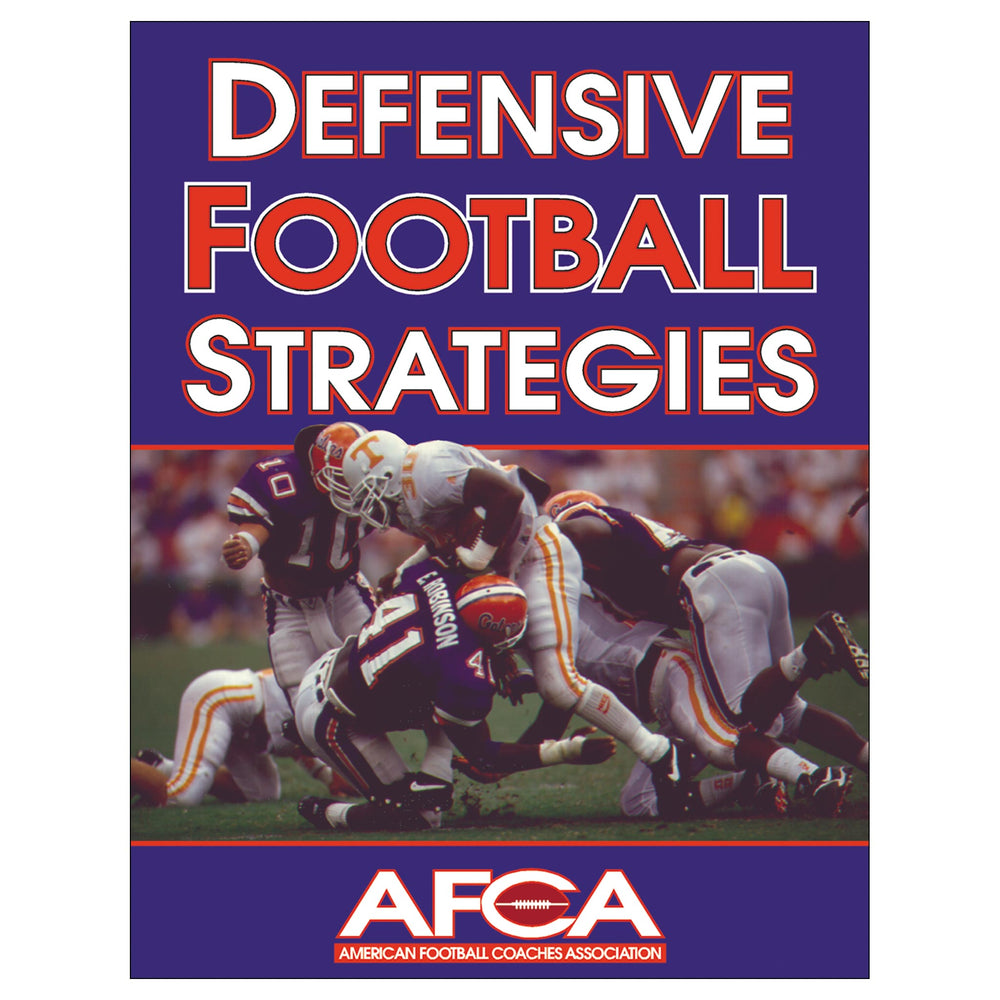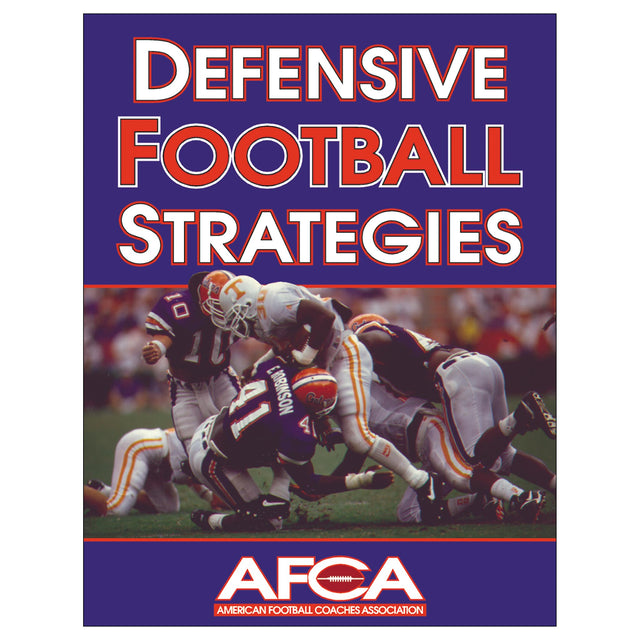Defensive Football Strategies
$32.95 USD
They say that defense wins championships. If so, this book is your formula for winning a title with a solid defensive football team.
Defensive Football Strategies is a complete collection of tactics, teachings, and insights from some of the best defensive minds in the game. Readers will find winning strategies from 90 top coaches—legends of both the past and the present—including Bob Stoops of the University of Oklahoma, Bo Schembechler of the University of Michigan, Charlie McBride of the University of Nebraska, and R.C. Slocum of Texas A & M.
Inside are 73 detailed presentations on many of football's most successful defensive systems used during the past 40 years. With the help of 600 X-and-O diagrams, the book covers these areas:
- Philosophies, fronts, and schemes
- Run defenses
- Pass defenses
- Formation and down-and-distance adjustments
- Goal line defenses
Defensive Football Strategies was developed in cooperation with the American Football Coaches Association. It's an expert resource that coaches can use to build a defense that will win it all.
Part I - Philosophies, Fronts, and Schemes
- Maximizing Your Defensive Personnel
Larry Jones
- Establishing a Winning Defensive Mind-Set
Bob Gambold
- Preparing the Defense During Game Week
Frank Maloney
- Teaching Techniques for a Multiple Defensive Package
Clyde Biggers
- Creating a Multiple Defensive Scheme
Ken Donahue, Pat Dye, and Bill Oliver
- Defending With Multiple 8-Man Fronts
Jim Weaver
- Contrasting the 7- and 8-Man Fronts
- Building the Even Defense
Dan Devine, Al Onofrio, and Clay Cooper
- Using the 4-3
Eddie Robinson
- Coordinating the 4-3 Defense
David McWilliams
- Pressuring With a Multiple 4-3
Bob Stoops
- Coaching the Tilt: The Stunting 4-3
George Perles
- Switching From the 50 to the 4-3
Grant Teaff
- Choosing the 4-3 Over the 50
Joe Novak
- Defending With the 50
Foge Fazio
- Coordinating Run and Pass Defenses
George Welsh
- Swarming the Offense
Dick Tomey, Rich Ellerson, Larry MacDuff, and Johnnie Lynn
- Pressuring Without Risk
Frank Beamer and Michael Clark
- Establishing a Base Defense
Bill Dooley
- Soaring With the Eagle Defense
Craig Bohl and Dean Campbell
- Gaining a Numbers Advantage
Denny Marcin, Chris Cosh, and Dan Martin
- Getting an Edge With the 3-4
Norm Gerber
- Developing the Multiple 3-4 Package
Phil Bennett and Larry Slade
- Blitzing Against Anything
Joe Lee Dunn and Tom McMahon
- Forcing Turnovers for Victories
Brock Spack
- Preventing the Big Play
Bo Schembechler and Gary Moeller
Part II - Run Defenses
- Using the 6-2-2-1 Against the Running Game
Dick Hitt
- Stopping the Triple Option With the 6-2
Chester Caddas
- Eliminating Options With the Junkyard Eight
Erskine Russell
- Standing Firm Against the Veer
Augie Tammariello
- Defending the Modern Wing-T
Roy Kramer and Herb Deromedi
- Drilling Run Defense at a Passing School
Dick Felt
- Freezing the Run With Multiple Fronts
Dan MacNeill
- Stuffing the Run With a 9-Man Front
Teryl Austin
- Using the Okie 5-2 to KO the Run
Rex Norris and Warren Harper
- Developing the Black Shirt Defense
Charlie McBride and George Darlington
Part III - Pass Defenses
- Fundamental Pass Defense
Jerry Claiborne
- Defense Against a Strong Passing Team
Frank Lauterbur
- Man-to-Man Pass Coverage
Gene Felker
- Man Defense Against All Sets
Don James
- Match-Up Man in Zone Coverage
Lou Wacker
- Zone Protection Vs. the Pass
John Majors
- The Swing Linebacker in Pass Defense
Dee Andros
- The 4-Deep Secondary
Hootie Ingram
- The 3-Deep Zone Coverage
Steve Bernstein
- The 2-Deep Zone
Mike Lucas
- The 2-Deep Vs. the 1-Back Set
Michael Hodges
- Secondary Coverages to Stall the Pass
Ron Schipper
- Multiple Pass Defense
Carmen Cozza
- Run and Shoot Defense
Del Wight
- The 3-5-3 Pass Defense
Frank Spaziani
- Pattern-Read and Combination Coverages
Bill Oliver
- Ingredients for Mixing Coverages
Pete Fredenburg
- The Nickel Package: Multiple, Yet Simple
Denny Schuler
- Coverage Adjustments Vs. the Passing Game
Dick Sheridan
- Flexibility in Defending the Vertical Passing Game
Lou Bronzan
Part IV - Formation and Situation Adjustments
- Executing Between Plays Helps Make Plays
Tommy Spangler
- Adapting to Formations and Motion
Bill Brashier
- Adjusting to Defend the Veer and Wishbone
Mike Campbell
- Defending the One-Back Offense
Tom Hayes
- Conquering the Long-Yardage Situation
Jerry Berndt
- Defending on 3rd and Short, Medium, and Long
Tom Hayes
- Covering on 3rd and Long
Bob Toledo
- Stopping the Offense Inside the 40
Denny Stolz, Ed Youngs, and Sherman Lewis
- Blitzing in the Red Zone
Norm Parker
- Preventing Points in the Red Zone
Charlie McBride
- Preserving a Victory With a Two-Minute Defense
Dave McClain
Part V - Goal Line Defense
- The 6-5 Goal Line Defense
Gene Stallings
- The 56 Lock-On Goal Line Defense
Dal Shealy
- Multiple Goal Line Defenses
Jim Carmody
- Combination Coverage on the Goal Line
Gary Blackney
- A Flawless Diamond Around the Goal
Mike Martin
- Goal Line Defense Vs. the Fade
R.C. Slocum
Since its establishment in 1922, the American Football Coaches Association has striven to provide a forum for the discussion and study of all matters pertaining to football and coaching and to maintain the highest possible standards in football and the coaching profession. These objectives, first declared by founders Alonzo Stagg, John Heisman, and others, have been instrumental in the AFCA's becoming the effective and highly respected organization it is today.
The AFCA now has more than 10,000 members, including coaches from Canada, Europe, Australia, Japan, and Russia. Through annual publications and several newsletters, the association keeps members informed of the most current rules changes and proposals, proper coaching methods, innovations in techniques, insights in coaching philosophy, and business conducted by the board of trustees and AFCA committees. A convention is held each January to give members a special opportunity to exchange ideas and recognize outstanding achievement.
The association promotes safety in the sport and establishes strong ethical and moral codes that govern all aspects of football coaching. In addition, the AFCA is involved in numerous programs that ensure the integrity of the coaching profession and enhance the development of the game. It works closely with the National Collegiate Athletic Association, the National Association of Collegiate Directors of Athletics, the National Association of Intercollegiate Athletics, the National Football League, the National Football Foundation and Hall of Fame, Pop Warner, and other organizations involved in the game of football. Indeed, one of the goals of the association is to build a strong coalition—TEAM AFCA—of football coaches who will speak out with a unified voice on issues that affect the sport and profession.
The AFCA is the team of the football coaching profession. All current and former football coaches or administrators involved with football are encouraged to join. For more information about becoming a member of the American Football Coaches Association, please log on to the AFCA Web site (www.afca.com) or contact them at the following address:
American Football Coaches Association
100 Legends Lane
Waco, TX 76706
(254) 754-9900





